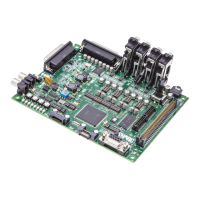Functional Description
10-14 ADSP-214xx SHARC Processor Hardware Reference
companding algorithms, A-law and μ-law, performed according to the
CCITT G.711 specification. The type of companding can be selected
independently for each SPORT. Companding is selected by the
DTYPE
field of the SPCTLx control register.
Companding is supported on the A channel only. SPORT0, 2, 4
and 6 primary channels are capable of compression, while SPORTs
1, 3, 5 and 7 primary channels are capable of expansion.
In multichannel mode, when compression and expansion is
enabled, the number of channels must be programmed via the NCH
bit in the SPMCTLx registers before writing to the transmit buffer.
The SPxCSn and SPxCCsn registers should also be written before
writing to transmit buffer.
When companding is enabled, the data in the RXSPxA buffers is the
right-justified, sign-extended expanded value of the eight received LSBs. A
write to TXSPxA compresses the 32-bit value to eight LSBs (zero-filled to
the width of the transmit word) before it is transmitted. If the 32-bit value
is greater than the 13-bit A-law or 14-bit μ-law maximum, it is automati-
cally compressed to the maximum value.
Transmit Path
If the serial port is configured as a serial transmitter, the data transmitted
is written to the TXSPxA/TXSPxB buffer. The data is (optionally) com-
panded in hardware on the primary A channel (SPORT 0, 2, 4 and 6
only), then automatically transferred to the transmit shift register, because
companding is not supported on the secondary B channels. The data in
the shift register is then shifted out via the SPORT's SPORTx_DA or
SPORTx_DB signal, synchronous to the SPORTx_CLK clock. If framing signals
are used, the SPORTx_FS signal indicates the start of the serial word
transmission.

